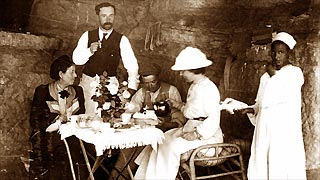Egypt
 Liverpool Daily Post
Liverpool Daily Post
See the above link for the three-page story.
- Exhibition: John Garstang
Lancashire Telegraph THE work of a legendary archaeologist is being celebrated in an Egyptian exhibition in Blackburn and Burnley this year. John Garstang pioneered modern techniques of photographing grave goods at the turn of the 20th Century. Born...
- Lecture Summary: Lecture Reveals History Behind Ancient Egyptian Pottery
Truman State University Index (Jennifer Lewis) The Egyptian pottery residing in the Ophelia Parrish art gallery is accompanied by a story about how it had been unearthed and nestled safely in those glass cases. Sara Orel, art history professor and temporary...
- More Re New Gallery At World Museum, Liverpool.
Artdaily.org A major new gallery at the World Museum Liverpool looks at the incredible world of the Pharaohs and the remarkable culture that built the Pyramids and the Sphinx. Ancient Egypt, opening this Friday 5 December 2008, contains 1,500 fascinating...
- New Gallery At The World Museum, Liverpool, Uk
Art Daily With photograph. A major new gallery at the World Museum Liverpool looks at the incredible world of the Pharaohs and the remarkable culture that built the Pyramids and the Sphinx. Ancient Egypt, opening on December 2008, contains 1,500 fascinating...
- Egyptian Collection's New Gallery
http://tinyurl.com/m8ch8 (icliverpool.icnetwork.co.uk)"Liverpool's prestigious Egyptian collection is to get a new look - thanks to a £300,000 grant. World Museum Liverpool is one of 43 institutions across the country to benefit from grants totalling...
Egypt
Garstang at the World Museum, Liverpool
 Liverpool Daily Post
Liverpool Daily PostAs the first visitors take in World Museum Liverpool’s new Ancient Egypt gallery, Laura Davis explores the city’s long-standing fascination with the Land of the Pharaohs.
It was every bit the up-standing Edwardian tea party, with the brew sipped from bone china cups and the table decorated with a fringed cloth and a vase of rose s.
Despite the heat, the women were tightly buttoned up to the neck and the men wore waistcoats and smoked cigars.
But the setting was far from conventional. No sumptuous drawing room for these intrepid types, but the inside of an Ancient Egyptian tomb. These burial places had many uses. When he wasn’t breaking for tea, University of Liverpool professor John Garstang could be found carefully cataloguing his archaeological finds in the rock-cut tomb he used as his headquarters.
A photograph from the time reveals him boater-hatted, at a wooden trestle table – a selection of artefacts laid out on a cloth, draped over a sarcophagus. Another shows Garstang practising his golf swing in the middle of the desert, proving that a Edwardian gentleman could create a little corner of Merry Old England in the least likely of places.
Some of the items he found are among those on display in World Museum Liverpool’s new Ancient Egypt Gallery; others, given as gifts to his benefactors, have become lost among their other handed down possessions; but many of them are on display in the tiny Liverpool University museum that bears his name.
“Garstang was relatively unique in terms of British archaeologists because he came out of a university background,” explains Dr Steven Snape, the university’s director of Archaeological Collections.
“There were other people carrying out digs in Egypt, such as Flinders Petrie, of the Egypt Exploration Fund, but, because Garstang dug at so many sites and found so much stuff, he was really important in our understanding of the burial customs of ordinary Egyptians.”
While some archaeologists focused on the grand tombs of Pharaohs, filled with treasures, the Liverpool expeditions (from 1900 to World War I) were concerned with the anonymous masses. Garstang would spend several months at a time in the field, uncovering and labelling finds that, while less monetarily valuable than the items in the Royal tombs, were equally as illuminating.
See the above link for the three-page story.
- Exhibition: John Garstang
Lancashire Telegraph THE work of a legendary archaeologist is being celebrated in an Egyptian exhibition in Blackburn and Burnley this year. John Garstang pioneered modern techniques of photographing grave goods at the turn of the 20th Century. Born...
- Lecture Summary: Lecture Reveals History Behind Ancient Egyptian Pottery
Truman State University Index (Jennifer Lewis) The Egyptian pottery residing in the Ophelia Parrish art gallery is accompanied by a story about how it had been unearthed and nestled safely in those glass cases. Sara Orel, art history professor and temporary...
- More Re New Gallery At World Museum, Liverpool.
Artdaily.org A major new gallery at the World Museum Liverpool looks at the incredible world of the Pharaohs and the remarkable culture that built the Pyramids and the Sphinx. Ancient Egypt, opening this Friday 5 December 2008, contains 1,500 fascinating...
- New Gallery At The World Museum, Liverpool, Uk
Art Daily With photograph. A major new gallery at the World Museum Liverpool looks at the incredible world of the Pharaohs and the remarkable culture that built the Pyramids and the Sphinx. Ancient Egypt, opening on December 2008, contains 1,500 fascinating...
- Egyptian Collection's New Gallery
http://tinyurl.com/m8ch8 (icliverpool.icnetwork.co.uk)"Liverpool's prestigious Egyptian collection is to get a new look - thanks to a £300,000 grant. World Museum Liverpool is one of 43 institutions across the country to benefit from grants totalling...
